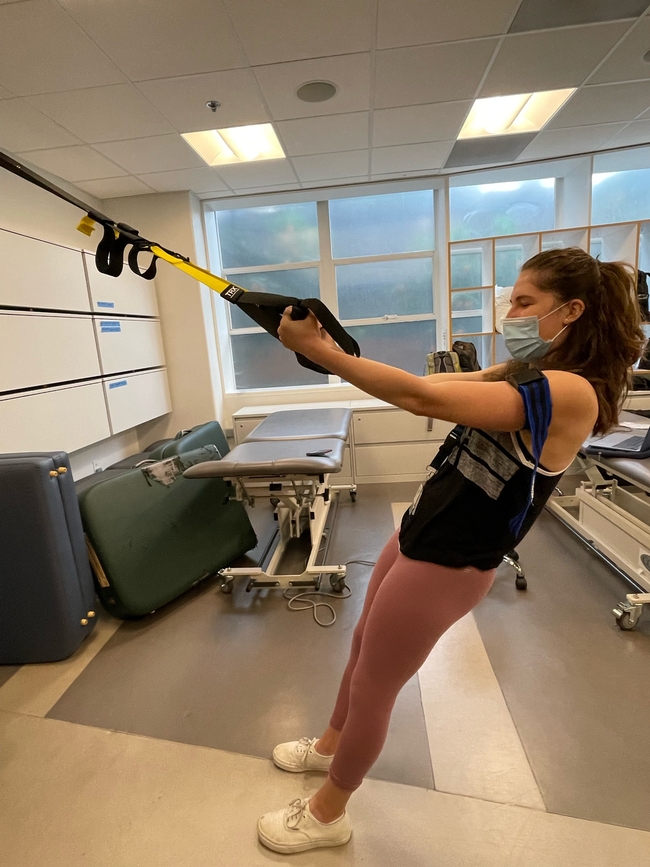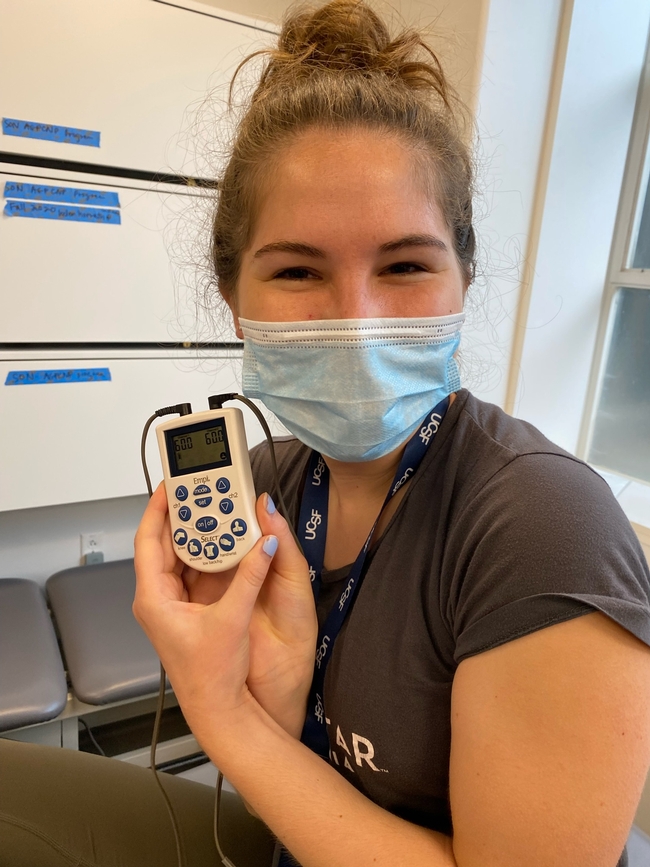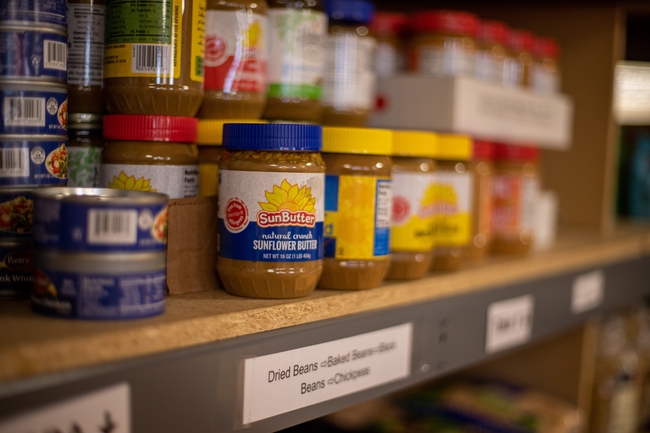Food pantries, improved CalFresh processes alleviate food insecurity on UC campuses
Nutrition Policy Institute researchers contribute to studies that inform policy changes
Marcela Gonzalez, who had wanted to be a physical therapist since she was a teenager, was in the final stage of realizing her dream.
But when she started in the PT program at the University of California San Francisco in 2021, a vexing struggle of her undergraduate years came back. Academic pressures and stomach troubles, compounded by financial worries, drained her of any energy and capacity to feed herself.
“I didn't eat; I lost a lot of weight because I just couldn't eat,” Gonzalez recalled. “I was too stressed out all the time; I was a mess.”
During her first year at UCSF, Gonzalez, for whom food has “always just been hard,” discovered that she qualified for CalFresh (California's version of the Supplemental Nutrition Assistance Program, formerly known as “food stamps”). Her participation in the program – as well as the presence of a campus food pantry – helped lift a heavy mental burden and allowed her to refocus on school.
To understand the mechanisms that connect eligible students with CalFresh benefits, which could greatly improve their lives and education, University of California researchers interviewed UC campus staff responsible for guiding undergraduate and graduate students through the application process. Their recently published study, which involved researchers at UC Agriculture and Natural Resources' Nutrition Policy Institute, illuminated several major facilitators and barriers to CalFresh enrollment.
Campus-county coordination, boosting staffing key factors
Ensuring that college students have access to CalFresh is especially crucial, given that food insecurity affects that segment of the population roughly four times the rate of the general population, according to the study's principal investigator and co-author Suzanna Martinez, an associate professor in the department of epidemiology and biostatistics at UCSF.
It's estimated that more than 40% of college students face uncertain access to healthy food – and inflation, the rising cost of attending college and increasingly unaffordable housing are likely to swell those numbers.
That's why researchers say it's critical for campus staff who work on CalFresh outreach to collaborate with the financial aid office and the county office that administers the CalFresh program locally. Through close coordination, staff members can determine if students meet the necessary exemptions and help them with the paperwork.
“When that happens, it's much easier than when a student applies without their campus Basic Needs coordinator, or when they just go to the county and apply on their own,” Martinez explained. “Maybe they don't know all of the verification documents that have to be included, or they might not know their financial aid status.”
Erin Esaryk, NPI research data analyst and first author of the study published in the Journal of Nutrition Education and Behavior, also highlighted the need for increased campus staffing to help with CalFresh enrollment, as well as more outreach by campus and county staff to student populations about the benefits.
“When there's a lot of outreach, that helps alleviate some of the stigma, to normalize the receiving of CalFresh,” Esaryk said.
Helping others worry less about food
Given her own history of travails, Gonzalez, the physical therapy student, wanted to help others at UCSF “de-stress” about food. In summer and fall 2021, she served as a “CalFresh ambassador” for her cohort of new PT students, developing presentations and guides that break down how to apply for or renew CalFresh benefits.
She became the go-to person for her classmates' questions on the logistics and details of applying for the program, and also encouraged fellow health-professional students who, like herself, did not think they would qualify.
“To take out less loans, or to not worry about food a little bit every week, is a great thing,” said Gonzalez, pointing out that subtracting food costs allows students to shave down their loans.
After helping introduce her classmates to CalFresh, she transitioned to working at the food pantry at the Parnassus campus. In addition to setting up and distributing the items, Gonzalez also posts on Instagram and TikTok (@ucsf_basicneeds) to promote the “food market,” which attracts about 100 students and campus community members every Thursday afternoon.
“You never know what you're going to get, but there's so much really good, fresh produce,” she said.
Campus food pantries deliver health benefits
Researchers are also studying how campus food pantries affect students' overall health, including easing the challenges of anxiety, depression and sleep deprivation. Another recent study published in the Journal of Nutrition Education and Behavior analyzed health-survey responses of 1,855 undergraduate and graduate students at all 10 UC campuses – before and after access to a campus food pantry.
“What we found was that students reported improvements in their perceived health and sufficient sleep,” said UCSF's Martinez, the lead author. “We also found that they reported fewer depressive symptoms, compared to before having access to the food pantry.”
By 2019, all UC campuses had established food pantries, although nationwide only about 25% of four-year colleges have one. The significant health benefits reported by UC students in this study give researchers hope that campus food pantries will see additional governmental support, in California and beyond.
“It was important to evaluate whether the food pantries were actually making a difference…if you don't have numbers or evidence, then you're not going to get funded to support future programming,” Martinez said.
Research guides state policy changes
Studies of food insecurity in the college setting have already informed policymaking aimed at smoothing the application process for CalFresh – benefits regarded by Martinez as a better long-term solution than food pantries, which constitute an emergency “short-term response” to the problem.
One example of the research's impact is a law passed last year in California that requires community colleges and California State University campuses to designate a campus-county liaison who would help students procure social services, including CalFresh. A separate law expanded the list of training programs within which students would potentially qualify for CalFresh, and another bill currently under consideration by the state Legislature would make the processing of students' CalFresh applications more consistent from county to county, through more standardized training of staff.
Meanwhile, on the research front, Esaryk, Martinez and their colleagues are completing a follow-up study on students and CalFresh enrollment, this time looking at the perspectives of county staff. And while their broader goal remains clarifying and streamlining student eligibility rules and processes at all levels, they remain focused on students and meeting their needs.
“Right now, our main mission is just to try to increase awareness of CalFresh for students and to let them know they may be eligible,” Martinez said, “and then assist them through that application process so they can actually get the benefits.”
In addition to Esaryk and Martinez, NPI director Lorrene Ritchie and Laurel Moffat of Washington State University are also authors of the CalFresh/SNAP benefits study, while co-authors of the college food pantry study are Ritchie, Gwen Chodur of UC Davis, Sevan Kaladijian of UC Irvine and Michael Grandner of the University of Arizona.



